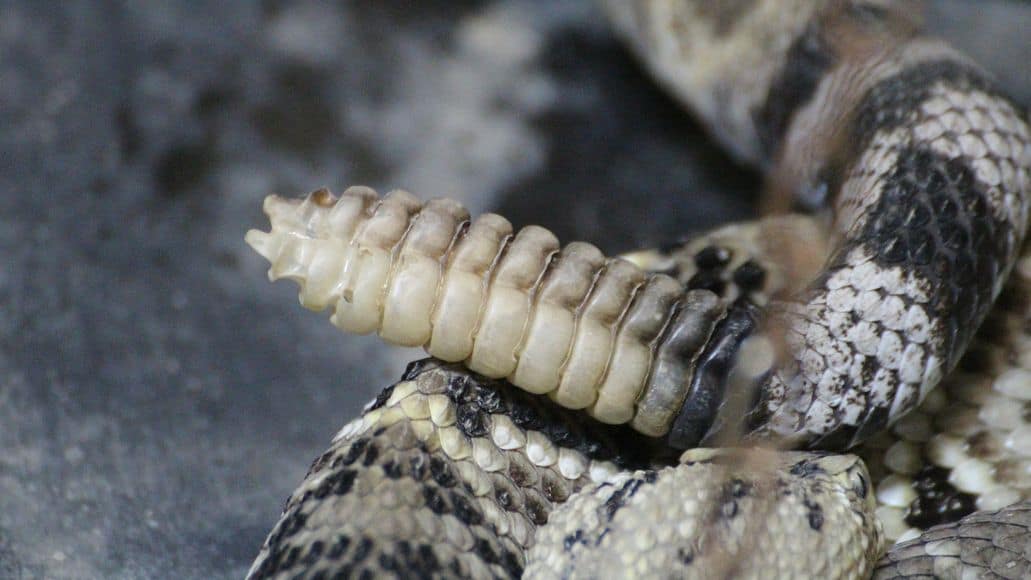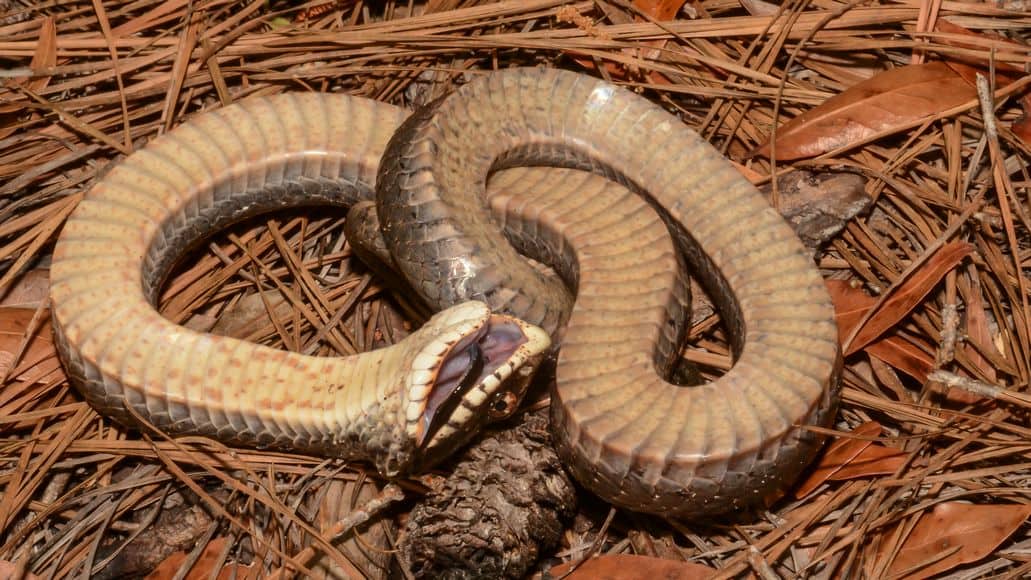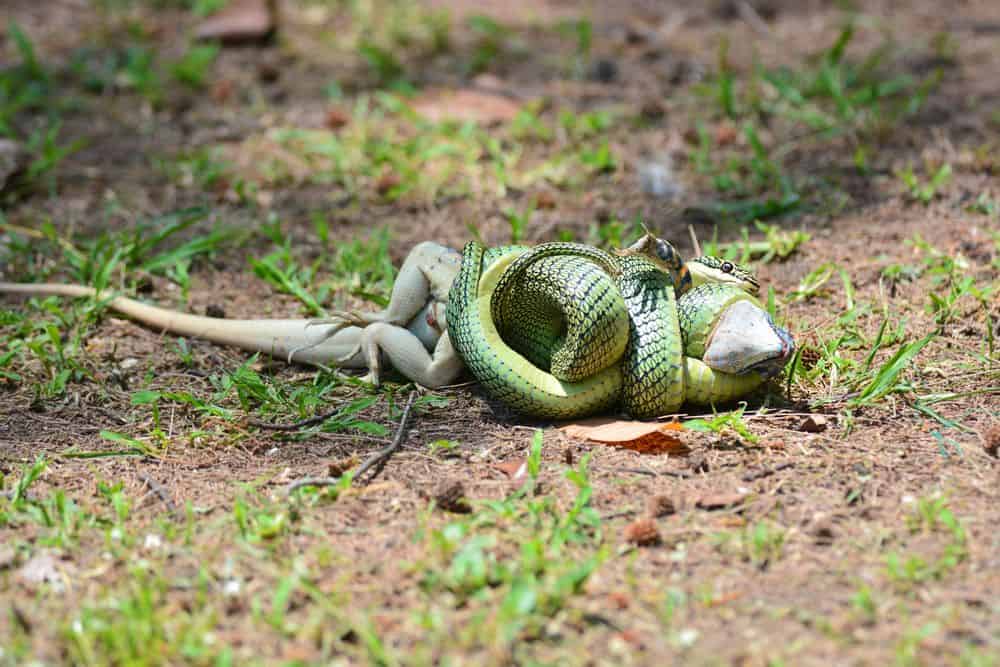
They thrive on 6 continents and in every climate zone except the coldest ones.
And they manage to do it without even having any limbs.
The reason for their success is a number of amazing evolutionary adaptations.
It is these unique snake adaptations that give them advantages over their prey and their predators.
And that is why snakes are such a success story.
Keep reading to learn all about some of these incredible adaptations and how they help give snakes some unique advantages.
Table of Contents
Snake Adaptations
We will break the snake adaptations down into several categories: physical adaptations, sensory adaptations, survival adaptations, reproductive adaptations and adaptations for eating. We also have a separate article specifically on desert snake adaptations.
Unique Physical Adaptations
Snakes have several physical adaptations that give them big advantages when hunting prey and when evading predators.
Fangs And Venom Delivery Systems
Snakes show fascinating and varied adaptations in their fangs and venom delivery systems. Some have highly specialized systems with venom toxicity tailored to specific prey. This helps enhance their hunting efficiency.
Some snakes, like spitting cobras, can spit their venom up to 3 meters, using specialized muscles to spray it accurately. This paralyzes their prey or predators. Check out this video on spitting cobras to see one spitting its venom.
Colubrid snakes have shortened maxillary bones, allowing their fangs to move forward for more effective venom delivery. Similarly, front-fanged snakes possess accessory glands that aid in venom production and storage.
Venomous snakes have evolved fangs with grooves or canals to direct venom into wounds, while some species can track prey post-bite. Additionally, pre-digestive proteins in venom help break down prey for easier digestion.
Skin And Shedding
Skin shedding is known as ecdysis and is vital for skin renewal. It also plays a crucial role in removing old skin and mating. Shedding also helps reveal pheromone-rich layers beneath.
Shedding frequency varies with age, species, health, bacterial presence, weather, and nutrition. Some species, like corn snakes, shed immediately after birth.
Others, like rattlesnakes, have unique shedding processes. The last rattlesnake scales on the tail end harden to form a new rattle with each shed. Each snake also has a unique friction profile, which helps in the removal of the old scales.
These adaptations ensure healthy skin maintenance and help snakes thrive in their environments.
Movement
Snake movement adaptations help them navigate diverse environments. As limbless creatures, they use various locomotion methods.
- Rectilinear movement: In this movement, the snake’s muscles contract in waves, which helps them move straight ahead.
- Sidewinding: This movement is especially efficient on sandy surfaces and is seen in desert snakes.
- Concertina movement: This helps snakes climb and navigate tight spaces by anchoring parts of their body while pushing forward.
- Slithering movement: Slithering is the most common snake movement and uses lateral undulation to slither.
- Swimming: Water snakes swim by creating lateral waves along their bodies to propel through water. They have gradually shortened hoods, which minimize water resistance. They are some of the best snakes at swimming.
Sensory Adaptations
Snakes have a number of amazing sensory adaptations to help them survive and thrive.
Vision

Snakes possess rods and cones in their eyes, which allow them to see in two-dimensional colors, primarily blue and green. Vision differs across species based on their habitat and hunting strategies.
Daytime hunters, like the False Water Cobra (Hydrodynastes gigas), have special lenses that block out ultraviolet light. This enhances their ability to see in bright conditions.
Nocturnal snakes, on the other hand, have lenses that allow more UV light to improve low-light vision. Some species can filter shorter wavelengths of light to enhance contrast and visibility.
Chemical Communication
Snakes have developed special chemical communication adaptations that play a crucial role in their survival and social interactions.
They use their forked tongues to collect chemical particles from the environment. They analyze these chemicals using the Jacobson’s organ, located in the roof of their mouths.
This system enables snakes to detect pheromones and chemical cues, helping them locate prey, mates, and other snakes. Chemical communication is vital for foraging and mating, as well as for marking territory with pheromones to deter competition and establish dominance within their habitat.
Survival Adaptations
Snakes possess a variety of survival adaptations that enhance their ability to avoid predators and thrive in challenging environments.
Easy Prey Detection
Pit vipers have pit organs, which are heat-sensitive cavities that enable them to detect infrared radiation and locate warm-blooded prey.
Warning Mechanisms

Rattlesnakes use their rattling tails as a warning signal to deter threats. Some snakes puff up their bodies to appear larger and more intimidating to predators.
Adapting To The Weather
In cold weather, snakes often hide and become inactive for months, a state known as brumation, to conserve energy. Snakes also bask in the sun to stay warm, as they cannot regulate their body temperatures. Despite this, there are a number of snake species that can live in cold climates, thanks to some clever survival strategies.
Regenerative Abilities
Certain snake species can voluntarily shed body parts to escape predators, with some capable of regenerating these parts.
Mimicry is another adaptation. Non-venomous snakes like kingsnakes and milk snakes mimic the appearance of venomous species to ward off potential predators.
Camouflaging
Snakes are masters of camouflage. Camouflaging helps snakes survive by allowing them to blend seamlessly with their surroundings. This makes them less visible to predators and unsuspecting prey.
This adaptation aids in ambushing prey and avoiding detection, while also increasing their chances of survival and successful hunting in various environments.
Playing Dead

Some snakes play dead to trick a predator into leaving them alone. The hognose snake is famous for this. Check out the video in this article to see a hognose playing dead. We also have an entire article of unique snake behaviors explained. Playing dead is one of the behaviors we take a closer look at.
Reproductive Adaptations
Snakes have evolved several reproductive adaptations to ensure the success of their offspring.
Hemipenes
Male snakes possess hemipenes, which are two penises that allow for greater flexibility and success in mating. The hemipenes also have a unique shape that helps keep the female attached longer until the sperm is released. This increases the chances of fertilization.
This article on snake penises goes into more detail. It includes photos of the bizarre-looking snake penises.
Internal Fertilization And Flexible Maternal Control
Internal fertilization ensures that sperm is effectively transferred to the female, and flexible maternal control allows for multiple mating strategies, seasonality, and varied reproductive modes and frequencies.
Females can influence the genotypes of their offspring through mate choice and sperm competition, enhancing genetic diversity. This article on snake reproduction explains it all (it’s quite fascinating).
Sheltered Egg-Laying
Many snakes lay eggs in sheltered locations to protect them from predators and environmental hazards, since most snakes do not provide parental care. Some species retain eggs longer, allowing them to give birth to live young, which can be advantageous in cooler climates.
Other Reproductive Adaptations
These include the male vomeronasal system, which detects pheromones and aids in locating receptive females.
Male-male rivalry often involves combat bouts, where males fight for access to females, while some males exhibit female mimicry to avoid confrontation and gain proximity to mates. Mate guarding prevents other males from mating with a receptive female, ensuring paternity.
Snake Adaptations For Eating

Snakes have developed remarkable adaptations for eating. Venomous snakes use specialized fangs to inject venom to immobilize their prey with toxins tailored to specific targets.
Constrictors like boas and pythons employ powerful constriction. They wrap their bodies around prey to suffocate them. Their long teeth aid in gripping prey, while some species use fang constriction to immobilize victims before swallowing.
Snakes dislocate their jaws to swallow prey much larger than their heads by expanding their mouths significantly. These adaptations enable them to efficiently capture and consume a wide variety of prey.
Evolutionary Snake Adaptations: Final Thoughts
Snakes exhibit a wide range of fascinating adaptations that enable them to thrive in diverse environments. Their unique physical adaptations, such as specialized fangs and venom delivery systems, skin shedding, and various movement methods, provide significant advantages in hunting and evading predators.
Sensory adaptations, including advanced vision and chemical communication, enhance their ability to detect prey and interact with their surroundings.
Survival adaptations like camouflage, warning mechanisms, and regenerative abilities further improve their chances of survival.
Reproductive adaptations ensure the success of their offspring, while their remarkable eating adaptations allow them to capture and consume a variety of prey efficiently.
These adaptations collectively showcase the incredible evolutionary ingenuity of snakes, making them highly successful and resilient creatures.
Leave a Reply